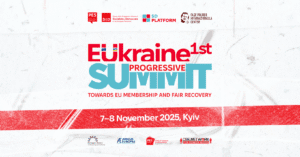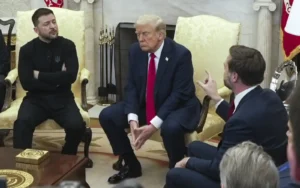The tensions that have been building up over the past few weeks have once again reminded the world community of the grave threat to European security posed by Russian aggression.
There is nothing more permanent than attempts to at least temporarily reduce the escalation in the zone of active hostilities, which has been the East of Ukraine for the past seven years. During this time, about 14,000 people were killed, and 1.5 million Ukrainians were forced to flee their homes. The region is in a very difficult humanitarian situation.
Until recently, some European leaders involved in the settlement process thought that the situation in Donbass was rather complicated, but controlled. They did not show much enthusiasm for the resumption of negotiations in the Normandy format. The last meeting of Volodymyr Zelensky, Angela Merkel, Emmanuel Macron and Vladimir Putin took place in 2019 in Paris. Prior to that, the pause stretched for three years.
The situation changed dramatically when alarms about a significant Russian military build-up on Ukraine’s borders reached government offices in Berlin, Paris, Brussels and Washington. For the first time, since 2014, Russia has defiantly heated the international situation to the maximum. The looming threat of full-scale military action between Russia and Ukraine has acquired new contours, forcing the world community to refresh its view of the current situation.
The revitalization of the negotiating platforms did not affect the protracted erosion of strategic stability, but nevertheless made it possible to achieve intermediate results. Last Thursday, Russian Defense Minister Sergei Shoigu ordered a number of units on the border with Ukraine to return to their bases. In addition, Vladimir Putin, in his Address to the Federal Assembly, focused mainly on issues of health care, social policy, economics, not forgetting to remind about the inadmissibility of crossing the so-called “red line” with respect to Russia.
At the same time, Ukrainian President Volodymyr Zelensky thanked international partners for their support and said that the reduction in the number of Russian troops on the border “proportionally reduces tension.”
It seems that it was possible by common efforts to repel the rapidly approaching threat to the European security this time, but at the same time, a reasonable question arises: “For how long?”
For Putin, the escalation in the East of Ukraine is needed primarily for a number of reasons, including for solving both external, geopolitical problems and internal issues:
1. Being in political isolation for a long time is fraught with serious reputational losses and Putin knows this very well. In his arsenal there are not many effective tools, when using which, the world leaders will be forced to talk to him. Aggressive behavior is one of them. With its nuclear status and a serious military-industrial complex, Russia is trying to impose its agenda from a position of strength. Its active involvement in inciting or “settling” certain hot conflicts, including support for separatists in the East of Ukraine, allows it to secure itself the status of an interested party, whose position must be reckoned with.
2. The Kremlin was unambiguously preparing for the arrival of the new US administration. Of course, Russians did not have much hope for a restart of relations, but nevertheless there were expectations that Biden was a representative of the old school and it would be easier to agree with him on possible points of contact, especially on security issues. However, the rather harsh rhetoric of the American president, including an affirmative answer to the question of Putin the killer, increased the bargaining power of Biden himself, forcing Putin to look for possible options for a response. The Kremlin did not think of anything else how to resort to a long-tried strategy – escalation in the Donbas and the possible threat of war. This, according to Putin, was necessary to start the inevitable conversation between Russia and the United States, and Biden’s call is confirmation of this.
3. The aggravation of the situation on the borders of Ukraine reminded the five-day Georgian war of 2008, when Russian troops entered into conflict with Georgia on the side of Abkhazia and South Ossetia – unrecognized so called republics. During this time, Russia managed to launch an offensive deep into the territory of Georgia and inflict damage on Georgian troops – and then achieve a profitable truce, avoiding full international isolation.
In this context, it is important to understand that Ukraine is not Georgia, and the Kremlin can hardly count on a quick victorious war. Firstly, the Ukrainian army of 2021 is qualitatively different from the army that was 7 years ago. Ukrainian soldiers gained real combat experience of confronting Russian mercenaries. Secondly, having started an open war with Ukraine, Putin must be one hundred percent sure that the Biden administration will not dare to fully engage in military involvement, but limit itself only to the next sanctions. And given the current geopolitical situation, he no longer has such confidence, so the risks are much higher than they were in the situation with Georgia. Thirdly, although Russian society is constantly being zombified by pro-Kremlin propagandists, it is not fully prepared for a full-scale war with the once “brotherly” country. At least one would like to hope so.
4. The post-Soviet space, unfortunately, is still a hotbed of instability. The main reason is Russia’s reluctance to accept the fact that some neighboring countries have expressed a desire to become part of the European Community. Putin recalls the collapse of the Soviet Union with bitterness. Even more irritating is the discussion about the potential accession of Ukraine and Georgia to the North Atlantic Treaty Organization. In order to prevent such a scenario, the necessary obstacles are being created – the so-called hotbeds of instability – on the territory of the Eastern Partnership countries. By tapping these pain points, the Kremlin believes it is in control and is holding back NATO expansion near its borders.
5. The struggle for Crimea continues. Ukraine, like its partners, was not ready for the fact that Russia would go to the annexation of the peninsula through military intervention. Unfortunately, Putin did not stop there either. He went further and began military operations in the Donbass, thereby strengthening his negotiating position. The Russian side did everything possible to move the “Crimean issue” outside the Normandy format. Crimea for Putin is a very strong consolidating factor, which replaces all the accumulated problems of Russian society associated with the resource economy, corruption, low incomes of citizens and large social gaps between the center and the periphery. Therefore, it is important for the Kremlin to use the option of “manual escalation” of the situation in Donbass in order to maintain the status quo regarding Crimea. Meanwhile, the peninsula is becoming more and more like a military base, where human rights and freedom of expression are hardly remembered.
6. Zelenskiy’s rise to power in 2019 was perceived in the Kremlin as a more favorable option than the continuation of Poroshenko’s presidency. The main focus of the his election campaign was aimed at finding peace and creating an adequate alternative to the post-Maidan political elite. No one could have imagined that two years later Zelensky would decide on those actions that President Poroshenko did not dare to take at one time. It is about delivering a serious blow to Putin’s closest ally in Ukraine, Mr. Medvedchuk. With just a few decisions of the National Defense and Security Council, Medvedchuk’s media and business empire was destroyed. His news channels were blocked, and sanctions were imposed on personal property and aircrafts.
In Ukraine, with the change of power, “runaway oligarchs” often appeared, but Mr. Medvedchuk always managed to stay afloat, even after the 2014 Maidan. His connections in the Kremlin helped him to occupy the niche of the main negotiator between Ukraine and Russia, especially in the context of the exchange of prisoners, as well as in resolving business issues. But Zelenskiy decided to change the current situation, thus sending a signal about the inadmissibility of promoting pro-Russian narratives that undermine the territorial integrity and sovereignty of Ukraine. Putin, in turn, could not help but answer. The threat of war should be perceived, first of all, as a reaction to the rather bold actions of the Ukrainian authorities in relation to the conductors of Russian interests inside Ukraine.
7. The September elections to the State Duma are forcing the Kremlin to more and more actively switch the attention of its citizens from current internal problems, aggravated during the pandemic, to protection from so-called external threats. The motive is clear – to mobilize society to vote for power again, even with the lack of positive changes. Another key task is to suppress the protest electorate. The favorite technology to enroll opposition leaders as “agents of the West” is especially effective during a period of exacerbation of the situation on external fronts, which is the escalation in Donbass. Such actions are fraught with the curtailment of any political competition within Russia and the next reproduction of power.
Thus, the confrontation between the West and Russia is intensifying. The partial relief of tension should not be interpreted as the Kremlin’s readiness to negotiate a possible settlement of the conflict in Eastern Ukraine. The real agenda with which Putin plans to work is not disclosed in the messages to the Federal Assembly, but is carefully prepared in a stream of closed special operations. There is no need to overestimate their importance, but it is important to carefully prepare for the next provocations that could shake the fragile structure of global security.
Bohdan Ferens, Founder of SD Platform (30 April 2021)
Image: PublicDomain (Flags Russia and Ukraine)



